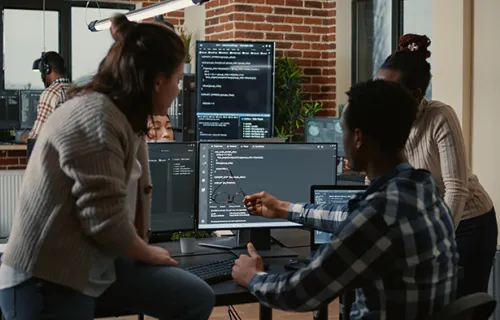Decisions are hard. Every “adulting” meme you see on social media reinforces that core belief. Government leaders charged with making modernization investments live this reality every day.
Federal leaders understand the imperative for modernization—reducing operational costs, increasing speed and agility, being more responsive to customer and employee demands. In our 2023 Voice of our Clients interviews, federal leaders cited modernization as the top business trend impacting their organizations. Making the decision to modernize – not difficult. Making the decision on how to modernize – much more challenging.
In any moment of decision, the best thing you can do is the right thing, the next best thing is the wrong thing, and the worst thing you can do is nothing. ~ Theodore Roosevelt
So, how do you, as an agency IT or business leader, make the best decisions regarding how you modernize? You need a structured approach that enables you to make informed choices regarding to-be architectures, based on a thorough analysis of what will work best within your organization. Your decision-making approach must consider not only the latest technology available in the market but, more importantly, your organization’s unique constraints, policies and ways of working.
Evaluating alternatives through DAR
The Decision Analysis and Resolution (DAR) process—part of the Capability Maturity Model Integrated (CMMI) Level 3—supports organizations in identifying architectural options and selecting the best approach. A mature DAR process promotes objective, informed decision-making, which reduces risk and promotes success when tackling hard-to-reverse decisions.
DAR is also useful for evaluating specific components of the architecture, either iteratively or on an ad hoc basis.
The DAR process guides the activities necessary to select the optimum frameworks, technologies, platforms or products to meet business needs. Using DAR, architects help organizations analyze possible decisions using a formal evaluation process, comparing the merits of identified alternatives against established criteria. DAR applies to build/buy analysis, options analysis and the feasibility of various approaches to achieving both technical and business objectives at the enterprise level or for a given modernization initiative.
Applying the DAR process with confidence and collaboration
DAR is often considered a technical evaluation process. That is an oversimplification at best. An effective DAR requires collaboration so that all stakeholders have confidence in the decisions made. An open, transparent DAR process encourages active participation in decisions while supporting holistic and well thought out decision-making based upon objective criteria.
When collaborating with clients to establish an effective DAR, look to instill the following principles within the process:
- Define a consistent approach for use across the organization. You should formally define, document and deploy your DAR structure and process to ensure consistency and institutionalization across your organization. This enables IT and business teams to make effective use of the process without confusion over how to begin. Leadership buy-in to the DAR process is vital to instilling confidence in the decision-making process.
- Develop evaluation criteria that are traceable and easy to understand. DAR teams must establish traceable evaluation criteria for requirements, scenarios, business case assumptions, business objectives or other documented sources. Spend ample time on establishing your evaluation criteria to ensure a targeted, yet holistic, focus. Typical criteria types include business requirements, technology limitations, environmental impact, risks, initial investment, lifecycle costs and compliance with agency-level or federal-wide standards.
- Apply organizational priorities to shape evaluation criteria. DAR members should represent the broad stakeholder community including business, technology, security and compliance. An architect can support the DAR team in arbitrating the importance of each stakeholder’s priorities as they work to establish thorough evaluation criteria. Involve your key decision makers throughout the DAR process, particularly when establishing evaluation criteria, to avoid late identification of requirements. This prevents subsequent debate regarding evaluation outcomes, based upon what some might see as incomplete or inappropriately-prioritized criteria. Include security and compliance criteria to avoid selecting an alternative that cannot achieve authority to operate.
- Evaluate based upon demonstrable results and complete information. Avoid using only vendor product materials when evaluating against criteria. Instead, perform your simulations, modeling, prototypes and pilots as necessary to exercise evaluation criteria, methods and alternative solutions. Agencies should apply the most thorough evaluation process possible in selecting a solution. Changing criteria partway through the DAR can affect the measurement work already completed and force re-evaluation of tools against the new criteria. If you a must make a decision with incomplete information, due to schedule and resource constraints, identify the risks, monitor them closely and re-analyze the alternatives later.
- Document, document, document. Teams must document the results of the evaluations—fully and carefully. If your team identifies new alternatives during the DAR, document the rationale for the addition of these new alternatives or methods, as well as any changes to the evaluation criteria based upon interim evaluations. Document the results and rationale for the recommended solution. As responsibility for a system or technology changes from one resource, team or organization to another, it is important that people joining your project team can readily access data showing how they reached previous decisions.
The DAR process is a key tool within CGI’s Responsive, Collaborative Digital Architecture (RCDA) approach. Learn more here.
Back to top




